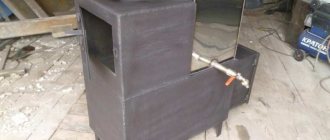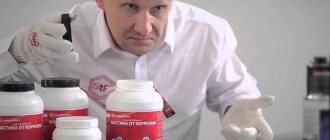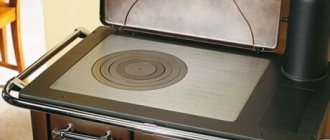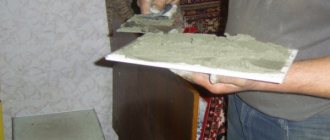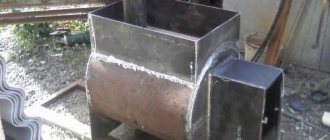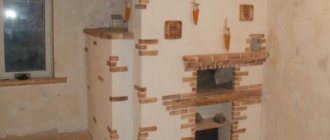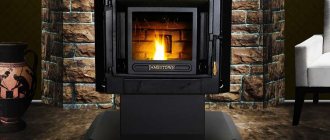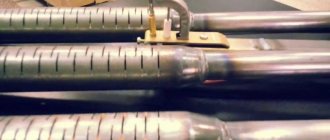Having a structure such as a fireplace or stove in the house, it is necessary from time to time to tidy up not only their internal chimney ducts, but also the appearance of these structures.
Fireplace painted with red heat-resistant paint
But in order not to get into an unpleasant situation and not to do wasted work, you need to know which paint is most suitable for stoves and fireplaces.
Is it possible to paint a metal stove?
Painting a metal stove is an essential process, but there are a number of additional factors to keep in mind. For this task, only heat-resistant paint for metal stoves is suitable, which can easily withstand exposure to prolonged temperatures. Many furnace owners choose a cheaper option that is not suitable for such tasks.
It is unacceptable to paint a metal stove with ordinary paint, since a number of useful functions of the paint and varnish material are lost, including:
- Heat resistance, which allows the metal to serve for many years without degradation under the influence of high temperatures;
- The absence of materials and additives that evaporate when heated and have a toxic effect on the body of others;
- The presence of protective properties against corrosive changes;
- Moisture resistance.
As you can see, the number of useful properties that paint for an iron stove should have is really many. Try to carefully understand the issue so that the service life of the product is maximum.
Rules for selection and use
To choose the right paint, you need to determine the maximum temperature of the surface on which it will be applied. You also need to calculate the area and make a choice between a spray in a can and a liquid consistency in a jar. But there are still some rules that you need to know.
Specific nuances in terminology
Many salespeople in their advertising campaigns are very frivolous with the terminology adopted for compositions that can be applied to surfaces with high temperatures. There is no normatively established gradation according to the correspondence between the name of the composition and its maximum permissible heating temperature.
However, three established terms are usually used:
- high temperature;
- heat resistant;
- heat resistant.
High-temperature paints for metal include compositions that can withstand prolonged surface heating up to 2000C. They are used for processing radiators and heating pipes, brick stoves and fireplaces. In addition, they are suitable for automotive parts such as engine, muffler and exhaust system.
Water jacket of a metal furnace. From the outside, it does not heat up above the temperature of the coolant, so high-temperature paint can be used to treat its surface
Heat-resistant compounds are used for surfaces with temperatures up to 6500C.
These paints are used for the following metal objects:
- sides and bottoms of furnaces;
- barbecues;
- pipes for exhausting combustion products;
- the junction of the water circuit pipes to the furnace or boiler.
Heat-resistant paints and enamels often contain pigments that give them color, so they can be used to create original interior design solutions.
Heat-resistant paint is designed to cover surfaces that are heated to temperatures above 6500C. First of all, these are cooking stoves and furnace fireboxes, as well as grates for wood-burning stoves and fireplaces.
Some types of thermal paint have an additional feature - fire resistance. This means that the painted surface may be in direct contact with the flame. Among household metal objects, this is relevant for the fireplace grate and the inside of the barbecue.
41beea72893d9672f5a3de2f07f53257.jpeTheory and practice of thermal hardening
Heat-resistant paint is essentially heat-resistant enamel. To create an impermeable barrier, it is necessary to perform a thermal hardening procedure. In the process of heating the surface with the composition applied to it, polymerization of the layers occurs, after which the access of air to the painted metal is stopped.
Sometimes, to protect metal products, a colorless varnish is applied to them. This type of coating also requires thermal hardening
It is after thermal hardening that neither oxygen, which causes the rusting process, nor moisture can penetrate under the enamel. Before this, the paint has only a decorative and, partially, protective function from physical impact.
Moreover, after creating an impermeable layer, the evaporation of substances contained in the paint into the room air stops. Therefore, ideally, it is necessary to wait until the specified period of complete drying, which is indicated on the label or in the instructions, and then immediately carry out the thermal hardening procedure.
Typically, the temperature at which enamel polymerizes is 200-2500C. This leads to one common mistake that is often made by people who have leftovers after painting their stove.
You cannot apply a heat-resistant compound that requires heat hardening to radiators and heating pipes, since the degree of their heating is insufficient to complete the process. For slightly hot objects, you need to use ordinary high-temperature paint.
Theoretically, the thermal hardening process should take place at a constant temperature for 30-60 minutes. However, in practice, such “laboratory” conditions are impossible to achieve.
Therefore, wood stoves, barbecues and fireplaces are not heated to full capacity and their heating is gradually increased. Typically a test run takes 1.5-2 hours. Another option is heating with an industrial hair dryer.
What to paint with?
A large number of requirements are placed on the paint and varnish material, but the modern chemical industry successfully creates dozens of paints that are ideal for such tasks. Construction stores offer products from dozens of manufacturers, but they are all divided into several large categories.
- The optimal heat-resistant paint for metal stoves is water-based acrylic. It is actively used for painting steel, brass, copper and some other alloys. The price is quite affordable, and the performance characteristics are suitable for many customers. An important advantage is the possibility of use in rooms where the air is not humid enough.
- Polyurethane varnish or enamel is also an excellent paint for a heavily used iron stove. The material can easily withstand high temperatures, and the metal surface acquires a beautiful silver tint.
- The most modern product is heat-resistant silicone paint for metal furnaces, which is marked KO-8101, 822 or 8111. According to ongoing research, the material can withstand temperatures above 650 degrees, and the absence of toxic substances will preserve your health. An unpleasant feature is the rather high price, which is compensated by the high quality of the products.
When can I heat it after painting?
After painting, the structure cannot be used until the paint or varnish is completely dry. How long this will take depends on the paint and varnish used and the number of layers applied.
The deadlines for different materials are as follows:
- The drying time of heat-resistant paint depends on the components included in it, often taking only an hour;
- The first layer of heat-resistant varnish dries in an hour, a total of 2-3 applications are needed, subsequent ones take longer to dry;
- It usually takes up to 2 hours for silicone enamels to dry;
- natural drying oil dries within 24 hours if the temperature is kept above 20°C.
Regardless of the paint and varnish used, it should dry completely within a day. It's better to wait longer for everything to dry completely. Impatience can result in complete failure, and then all the work will have to be done again.
Even an inexperienced user can handle painting a heating structure if you follow the work algorithm. Coloring can be done using different materials; one of the main conditions is the heat resistance of the selected product. You can make it yourself, which will reduce costs.
Which paint is best?
As mentioned earlier, the wide variety of paints allows customers to choose from several alternatives. You should take into account operating conditions, environmental properties (humidity, dust levels, etc.), as well as your financial capabilities. It is better to use expensive silicone paint, but for many it is still too expensive.
For iron
Iron furnaces are quite susceptible to degradation and oxidation, since the molecular structure predisposes the material to react with oxygen. High temperature also quite actively accelerates this process, which shortens the service life of the furnace.
If you want the stove to serve for many years, then you should use silicone paint from various manufacturers.
One of the leaders in the domestic market is Elcon, which has modern production. This manufacturer belongs to the “budget” class, but its quality is sufficient for domestic use.
It is important to carefully follow the painting technology, since otherwise the paint will not be able to protect against destructive factors. Remember that painting is not a universal solution that is guaranteed to protect the metal - it is important to follow the painting technology!
For cast iron
Cast iron is a fairly strong metal alloy that can withstand prolonged exposure to extremely high temperatures. Some sources report that you can avoid dyeing altogether, but it’s better to be on the safe side.
An excellent option for a cast iron stove is water-based acrylic or polyurethane paint, which has proven itself to be excellent. Moreover, the cast iron alloy tolerates even violations of the painting technology more favorably, so you don’t have to worry about making quite serious mistakes.
Where to start painting
Having chosen heat-resistant paint, do not rush to apply it to a brick or metal surface. If the packaging indicates preparatory steps, be sure to follow the recommendations. Basically, the following actions are required before painting:
- cleaning the structure from grease, salt, old coating;
- removing rust using sandpaper or sandblasting;
- drying and thorough washing;
- degreasing with solvent and painting after 6-7 hours (but no later than 24 hours).
Cleaning wheel for grinder
Palette of colors
If it is necessary to apply a second layer, wait until the previous layer has completely dried and only then continue processing the surface. Thermal paint must be of high quality: look at the date of manufacture, composition, name, address of the manufacturer. If any information is missing, look for another product, otherwise you risk harm to your health.
Preparing the oven surface for painting
The process of preparing the stove for painting is simple and straightforward, but it must be carried out in full, otherwise the consequences will be dire. It is important that pure metal remains under the paint layer without any additional impurities.
The process looks like this:
- Thoroughly clean the surface with a wire brush.
- Remove remaining oxides with a solution of sulfuric acid with a concentration of 5%.
- Wash off the acid with a mixture of laundry soap.
- Degrease the metal surface using any available method - usually a solvent.
- Paint the surface with paint.
There is nothing complicated in the process itself, but you should pay attention to the details, since this is where mistakes are made. This process may not seem like a big deal, but if you don't do it, the paint will start to fall off soon enough!
Application feature
There are no requirements for applying heat-resistant enamel as such. Painting is done with a roller, sprayer or brush. If you purchased enamel in a can, then you do not need tools.
Before applying paint, it is necessary to first prepare the surface, that is, remove rust, degrease and remove dirt. Before work, we recommend that you mix the paint well, after which the mixture should be kept for several minutes to remove air bubbles. We recommend applying the enamel in several layers. Apply the next layer after the previous one has already dried.
How to paint a metal stove?
The process of painting a metal stove is similar to similar work with other materials. Before starting work, make sure the quality of the paint - check the expiration date, the absence of lumps, additional impurities, etc. Mix the paint thoroughly, making movements not only in a circle, but also kneading the paint from the bottom.
It is necessary to paint a metal stove in an even, uniform layer. Pay attention to corners and seams, as these are the places where untreated surfaces most often remain. If you do not want to stain the surrounding area of the oven, then use cellophane and masking tape.
- You can use a brush to paint the stove.
- A can of spray paint is perfect for fittings.
Packaging
You can purchase heat-resistant paints in various packaging - these can be spray cans or jars. From cans, paint is simply sprayed over the surface, and from a can, paint is used with brushes, rollers or special sprayers.
The volume of the cylinder is usually 500 ml. Cans are produced in 400 g, 800 g, 2.5 kg and 5 kg. There are also large buckets of 5-15 kg and barrels.
Exactly how to apply thermal paint is everyone’s personal choice. For some, it will be more convenient to use a brush or roller, while others will opt for a spray can. In the latter case, the material consumption will be significantly lower, and the paint will apply more evenly and evenly.
Characteristics of enamel
The table presents the requirements for universal paints suitable for painting both stone and metal.
| Dry residue, % | 40 | 45/38 | 50 |
| Drying time, hour | 2 | 2 | 2 |
| Coating hardness, c.u. | 0,4 | 0,4 | 0,4 |
| Resistance to water, hour | 24 | 24 | 48 |
| Impact strength, cm | 40 | 40 | 40 |
| Heat resistance at +600 C, hour | 5 | 3 | 3 |
| Consumption per year/sq. m. | 130–150 | 130–150 | 130–150 |
| Salt spray resistance | 96 | 100 | 96 |
Tests are carried out at normal temperature +20 C and when heated. Data is given for normal temperature.
Which steel is better to choose?
For different options for using and installing the furnace during production, you will need to use different types of steel, including heat-resistant steel. We will analyze the main places for possible installation of the furnace and the optimal choice of steel for its production.
For sauna stove
In this option, the heater will heat up to a maximum of 5000, so deformation of the structure is possible if the production technology and choice of material are not followed. But individual parts heat up differently, so the grade of steel for a sauna stove may vary for its different parts:
for the production of the combustion chamber, you will need to prepare blanks from steel, grade AISI 430 or 08Х17Т. But such steel is difficult to obtain and expensive to use when making a stove yourself. In this case, you can use structural steel, but of a higher grade
The best option is St-10; to prevent direct passage of heat into the chimney, you can use simple structural steel or 08PS, 08Yu on the heat screen; for the production of the body, you can prepare the usual St-3; For the firebox door, it is important to prepare good material from heat-resistant steel or cast iron. In specialized stores or at flea markets, you can find excellent used doors for little money;
Important! When selecting material for self-production or buying a ready-made heater, pay attention to the thickness of the workpieces. If a heat-resistant alloy is used, the wall thickness is 4 mm. When using ordinary structural steel, the parts must be made of metal with a thickness of 6-8 mm.
When using ordinary structural steel, the parts must be made of metal with a thickness of 6-8 mm.
For home
The structure is exposed to long-term thermal loads, so it is important that the parts are made of good material. You can use steel for a sauna stove for a home potbelly stove, but it is better to prepare blanks from alloys with a chromium content of 12% or more
The famous stoves of Professor Butakov from and are made from such a sheet. They will last much longer than homemade ones made from scrap materials. We should not forget the thickness of the walls of such furnaces. Made of alloy steel with a high level of resistance to deformation during prolonged heating, the furnaces can be made of sheet steel 4-5 mm thick.
If the stove is installed in a small country house and you plan to use it only in the fall or early spring during rare visits to the site, you can make a homemade stove from a pipe or gas cylinders with a convection system. This design is cheap and can heat the house for a long time.
For garage
For a garage, using expensive heat-resistant or heat-resistant steel is an unaffordable luxury. This stove is used for a short time and not very often. Therefore, by making a stove from rims or sheet metal, 3-4 mm thick, you can easily solve the problem of heating a garage space.
Fireplace decorating techniques
To stylize the design, you can use a technique such as highlighting the seams. The fact is that masked seams look uninteresting, while highlighted seams look unusual and creative. For standard brick-colored masonry, sandy, yellowish or white paints are usually used, which are applied to the seams using a thin brush. If there is no paint, mix turpentine and varnish in equal proportions, add a drop of gouache and use the composition in the same way.
You can also decorate the fireplace in other ways:
- paint a pattern on the front surface of the building;
- make a drawing using a stencil;
- paint metal elements in a contrasting color;
- create an imitation of wear and aging on the surface of the masonry (for example, make translucent strokes with lighter paint).
Contrasting design
There is no need to be afraid of experiments. Even with your own hands, you can completely transform an old fireplace and turn a banal design into a chic and sophisticated interior decoration.
Manufacturing
- The base is made of red brick. To do this, you need to lay out two rows so that the seams do not coincide with each other. The base should be 20–30 cm larger than the stove itself.
- The firebox is assembled from individual sheets of cast iron. It should be rectangular. Inside it needs to be divided into two parts by a parallel sheet. At the bottom there will be an ash drawer. The separating sheet must have many holes through which waste will flow after combustion.
- After assembling the metal box, you need to make holes on the top to which the chimney from the pipes will be attached.
Principle of operation
The operating principle of stoves operating on wood and electricity is based on the possibility of automatically turning on electric heating elements when the temperature drops (after solid fuel burns out). This happens as follows:
- Kindling and heating of the stove is carried out using firewood. Since the firebox is located at the bottom of the device, it transfers heat from the burning wood to the upper part of the device - to the heat exchanger. An increase in coolant temperature is detected by a sensor installed in the system line;
- when the temperature begins to drop due to fuel burning, the electrical circuit is automatically closed and electric heaters are connected to operation;
- from this moment on, the specified coolant temperature parameters are maintained by the heating elements, based on the readings of the air or water sensor;
- when loading the next batch of solid fuel, the electrical part is automatically switched off, as the coolant is heated
- already from the side of the combustion chamber.
This transition from wood heating to electric heating and vice versa ensures continuous heating of water in the heat exchanger, which allows you to maintain the optimal temperature in the house around the clock.
Wood and electric stoves come in two types:
- single-circuit - connected to the heating system and used only for heating;
- double-circuit - designed to heat the coolant in the heating system and hot water for domestic needs.
